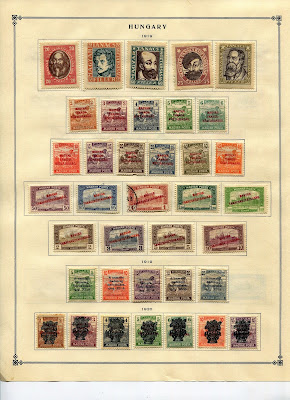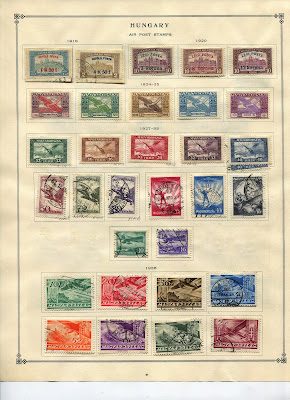Hungary Cover - a censor-inspected Debreczin
Bud's Big BlueBud's Observations
For a small country, Hungary issued mountains of stamps: 38 scans
follow, more than for any other country in Bud’s BB. All of BB’s 619 Hungary spaces
are filled and, on supplement pages, follows an even larger assortment of those
omitted by BB’s editors -- souvenir sheets, local issues, and the ten series of
occupation stamps. It’s a start on a specialization, but to collect classic
Hungary properly I’d need to acquire covers like one shown above -- a
censor-inspected Debreczin. And, I’d need to sort out the fakes.
Stamp output peaked in 1919 -- overprints, occupation issues,
local stamps, as well as the regular issues. Ugly, many of them are. But they’re
not wallpaper or propaganda stamps meant to bilk collectors, although they may
seem so. Instead, they are blood-stained, turmoil-infected cankers of World War
I and its aftermath. In their wretchedness lies their grandeur. Anyone who
investigates these stamps gains not only historical insights but also solid
wisdom about the human condition -- a miserable catastrophe, often, punctuated
by moments of elation. Much of what happened in world-wide philately during and
after WWI is best understood in light of events in Hungary.
The 1919 occupation overprints are infected with fakery,
some of them showing fake experts’ initials stamped on the back (famously,
PAPE). Because of this, I’ve included some cancelled examples, although they
might be fakes, too. Overprints woo forgers, especially in times of political
upheaval.
Here’s a simple exercise to uncover some of the richness of
Hungarian stamps: spend an evening googling
how and why the country name inscriptions changed so often during the classical
era:
·
Magyar Kir. Posta (Kingdom of Hungary Post,
with a real King).
·
Magyar Posta
·
Koztarsasag (Republic)
·
Magyar Tanacskoztarsasag (Hungarian Soviet
Republic)
·
Back to Magyar Kir. Posta (no king this time)
·
Magyarország
Or for lighter fare, google the two national symbols – the
crown of St. Stephen and the mythical Turul bird.
Census: 619 in BB spaces, 29 tip-ins, 644+ on supplement
pages, trending upward.
Jim's Observations
Note: Because of the large number of pages for Hungary in BB, this post will be featured for a longer period of time.
The 1871-1916 era...
The Scott Classic Specialized catalogue has, from 1871-1916, 103 major numbers for regular issues. There are, however, 135 minor numbers, mostly different perforations, although differences in watermark are also found. These minor numbers are fully as important for Hungarian philately as the major numbers, and should be treated as such. In fact, the Deep Blue (Steiner) album provides spaces for most of these "minor" numbers. In addition, there are 52 semi-postals during this era that will also be included in the survey.
Altogether, from 1871-1916, there are 290 catalogue number possibilities. Of those, 173 (60%) are CV <$1-$1+. Hungarian stamps, especially after 1881, are modestly priced for the WW classical collector.
The Scott Classic catalogue has, from 1916-1940, 338 regular and 70 semi-postal stamps. Of those, 313 (93%) of the regular, and 45 (64%) of the semi-postal stamps are CV <$1-$1+. Clearly, Hungary is inexpensive for the WW classical collector for this time era.
Despite being inexpensive, Hungary's stamp designs are very striking indeed.
Be aware that the "Harvesting Wheat" and "Parliament Building in Budapest" designed stamps, with their many iterations, are a bit of a challenge.
• Hungary issued some 139 Scott recognized major number Postage Due stamps,a large number. Along with their neighbor, Austria, they took collecting the proper postage quite seriously.
• Newspaper stamps were likewise issued, much like their neighbor Austria. These were special rates for newspaper periodicals in the mail. It is generally a reflection of a literate, educated, and intellectually curious population when one finds Newspaper stamps as part of the stamp production.
• Most astounding are the large number of Occupation stamps overprinted on Hungarian stamps by the occupying forces in Hungary after WWI. This is a reflection of the dismemberment of Hungary and it's lands, that occurred following the Great War.
Blog Posts and BB Checklists
Hungary 1871- 1916
Hungary 1916-1940
Hungary BOB, Occupation
Page 1
1a
1b
1c
Page 2
2a
2b
2c
2d
Page 3
3a
3b
3c
3d
Page 4
4a
4b
4c
4d
Page 5
5a
5b
5c
5d
Page 6
6a
6b
6c
6d
Page 7
7a
7b
7c
7d
Page 8
8a
8b
8c
8d
Page 9
9a
9b
9c
Page 10
10a
10b
10c
Page 11
11a
11b
11c
11d
Page 12
12a
12b
12c
Page 13
13a
13b
13c
Page 14
14a
14b
14c
Page 15
15a
15b
15c
Page 16
16a
16b
16c
16d
Page 17
17a
17b
17c
17d
Page 18
18a
18b
18c
18d
Page 19
19a
19b
19c
19d
Supplements
Page 1
Page 2
Page 3
Page 4
Page 5
Page 6
Page 7
Page 8
Page 9
Page 10
Page 11
Page 12
Page 13
Page 14
Page 15
Page 16
Page 17
Page 18
Page 19
Comments appreciated!












































































































Those Occupation Overprints!!
ReplyDeleteI have found some useful explanations of fake/genuine in 'Catalog of Hungarian Occupation Issues 1918-1921' by Christopher Brainard. It can be found on Hungarian Stamp Exchange. For sure another specialty pursuit.
Another great post on your excellent blog, thanks!!
Thanks, Roy, for the Brainard suggestion. Its $50 price likely will put off most BB collectors, but it's a must-have for any Hungary specialist. And, thanks for the encouragement.
ReplyDelete